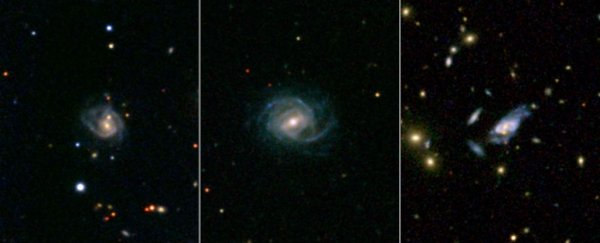Astronomers have found a new type of galaxy called 'super spirals' that are a lot like normal spiral galaxies just, you know, super-sized. In fact, they're one of the biggest and brightest objects in the Universe, and they were hiding right in front of researchers for years.
According to a team from the Infrared Processing and Analysis Centre (IPAC) at the California Institute of Technology, the newly found super spirals are 8-14 times brighter than the Milky Way, possess 10 times as much mass, and create 30 times more stars. They can also span a mind-boggling 440,000 light-years in width. Basically, they put our measly 100,000-light-years-wide galaxy in its place.
The researchers were able to find these super spirals by analysing data from the NASA/IPAC Extragalactic Database (NED), an online database of over 100 million galaxies contributed to by a plethora of research centres from around the world.
Though they set out to examine the brightest galaxies and thought that 'ellipticals' - a type of huge galaxy that looks a lot like a football - would take the cake, they were surprised when out of the 800,000 galaxies they studied, most of the brightest ones were spiral instead of elliptical.
They verified their findings by measuring how far away each spiral lies from Earth to make sure some weren't just looking large because they were closer than others.
Since spiral galaxies are not supposed to exist on such a massive scale, it seems that no one really ever paid attention to the images. Basically, when other teams looked at it, they wrote off the spiral galaxies by figuring they were just closer than other galaxies, and that's why they looked bigger or the same size.
However, as the new research shows, these galaxies and actually really, really far away and, therefore, super-huge. It's almost like the images were playing tricks on the exact scale of these humungous spiralled giants.
"It's as if we have just discovered a new land animal stomping around that is the size of an elephant but had shockingly gone unnoticed by zoologists," said lead researcher, Patrick Ogle. "Super spirals could fundamentally change our understanding of the formation and evolution of the most massive galaxies. We have much to learn from these newly identified, galactic leviathans."
Finding super spirals in NED goes to show that sometimes exciting new information is hidden in older data. Who knows what else may be lingering right under our noses?
The findings have been published in The Astrophysical Journal.
